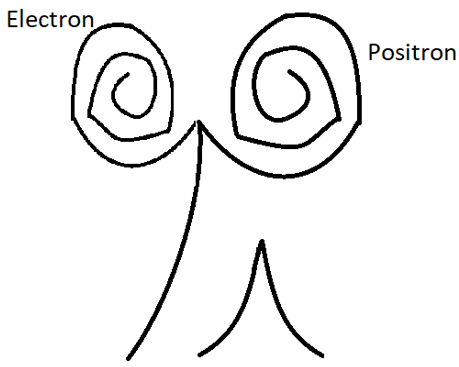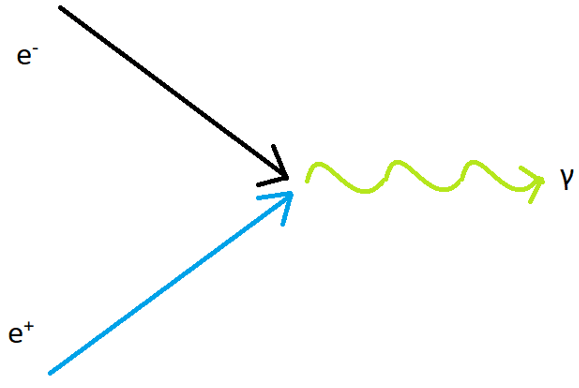This set of Engineering Physics Multiple Choice Questions & Answers (MCQs) focuses on “Pair Productions”.
1. What is the relation between the interaction parameter, ‘b’, and atomic radius, R, for the Pair Production?
a) b > R
b) b ≈ R
c) b < R
d) No relation between b and R
View Answer
Explanation: If b < R, the photon is directly converted into an electron-positron pair, known as pair production.
If b > R, it means the interaction parameter is greater than the atomic radius. In this case, the electron is ejected by the photon and it is known as the Photoelectric effect.
If b ≈ R, the incident photons are scattered by the electron of the atom and the electron itself gets scattered. This phenomenon is known as the Compton effect.
2. For Pair Production phenomenon to occur the photon must have energy, greater than or equal to ______________
a) 0.51 MeV
b) 1.02 MeV
c) 0.32 MeV
d) 0.85 MeV
View Answer
Explanation: In Pair Production, a proton with energy, greater than or equal to 1.02 MeV is required to create a pair of electron and positron. 1.02 MeV is the minimum required energy for their creation.
3. What kind of photon is required for the pair production phenomenon to occur?
a) Visible Light Photon
b) X-ray Photon
c) γ-ray Photon
d) UV Photon
View Answer
Explanation: When a γ-ray Photon passes close to an atomic nucleus (b < R) and it possesses energy greater than 1.02 MeV, the photon is converted into electron-positron pair. This is called pair production.
4. What is the rest mass energies for electron, Ee, and positron, EP?
a) Ee = 1.02 MeV, EP = 1.02 MeV
b) Ee = 0.51 MeV, EP = 1.02 MeV
c) Ee = 1.02 MeV, EP = 0.51 MeV
d) Ee = 0.51 MeV, EP = 0.51 MeV
View Answer
Explanation: The rest mass energy for both electron and positron is 0.51 MeV. Therefore, the incident photon must have energy greater than or equal to 1.02 MeV.
5. Charge and momentum are conserved in Pair Production.
a) True
b) False
View Answer
Explanation: Both charge and momentum are conserved in pair production. However, the presence of the nucleus is necessary for the conservation of momentum.
6. A 3.0 MeV photon interacts with a lead nucleus in empty space. What would be the Kinetic Energy of the electron and positron pair?
a) 2.01 MeV
b) 1.5 MeV
c) 1.45 MeV
d) Electron-Positron pair won’t be created
View Answer
Explanation: It is given in the question that the photon strikes the nucleus in empty space. In empty space, the law of conservation of energy and momentum does not take place. Thus, pair-production won’t occur.
7. A photon of energy 4.1 MeV is incident on a lead nucleus, causing the creation of electron-positron pair. They travel perpendicular to the initial direction of the photon. The energy of the electron is ____________
a) 4.1 MeV
b) 2.05 MeV
c) 1.02 MeV
d) 0.51 MeV
View Answer
Explanation: We Know, in pair production momentum and energy is conserved.
By conserving energy, Etotal = Ee + EP
4.1 MeV = Ee + EP
Now, by conserving momentum in y-direction we get
Pe – PP = 0
Pe = PP
Hence, if momentum is same the energy should be same
Therefore, 4.1 MeV = 2Ee
Ee = 2.05 MeV.
8. What is the direction of the magnetic field?

a) Inside the plane
b) Outside the plane
c) Upwards
d) Downwards
View Answer
Explanation: Form the figure, we realize that the positron rotates anticlockwise while the electron rotates clockwise. Thus, the magnetic field would cause a positive charge to rotate anticlockwise. Using the Right-hand thumb rule, the direction of the magnetic field is outwards the plane.
9. Pair production does not occur in X-ray imaging.
a) True
b) False
View Answer
Explanation: Pair production generally does not happen in X-ray imaging because the devices are rated at around 150 kV.
10. Which phenomenon is shown in the figure?

a) Pair Production
b) Photoelectric Effect
c) Compton effect
d) Pair annihilation
View Answer
Explanation: In the figure, an electron and a positron annihilate each other and release the equivalent amount of energy. This process is called Pair annihilation. It is just the opposite of pair production.
Sanfoundry Global Education & Learning Series – Engineering Physics.
To practice all areas of Engineering Physics, here is complete set of 1000+ Multiple Choice Questions and Answers.
If you find a mistake in question / option / answer, kindly take a screenshot and email to [email protected]
